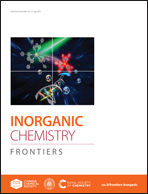Boosting photocatalytic hydrogen production activity by a microporous CuII-MOF nanoribbon decorated with Pt nanoparticles†
Abstract
Improving the photocatalytic efficiency for hydrogen evolution from water splitting plays a vital role for the feasible applications of clean and sustainable hydrogen energy production. A crystalline microporous CuII-based metal–organic framework (CuII-MOF) and a series of three Pt/CuII-MOF nanoribbons decorated with different loadings of Pt nanoparticles (NPs) have been synthesized and used subsequently as photocatalysts for hydrogen production via water splitting. Resulting significantly from the synergistic effects between the catalytic active CuII and Pt centers, the optimized Pt(4.38 wt%)/CuII-MOF nanoribbon exhibits an enhanced hydrogen generation rate up to 2.51 mmol g−1 h−1, remarkably higher by 4.7 and 1.9 times than those of the referential Pt NP and CuII-MOF. The electronic interactions between the Pt and CuII sites in the composite favorably dominate the potential of the conductive band and decrease the charge transfer resistance. These interesting results highlight an effective strategy for the rational design of a highly robust and microporous MOF-based composite with multiple photoactive metal sites.



 Please wait while we load your content...
Please wait while we load your content...